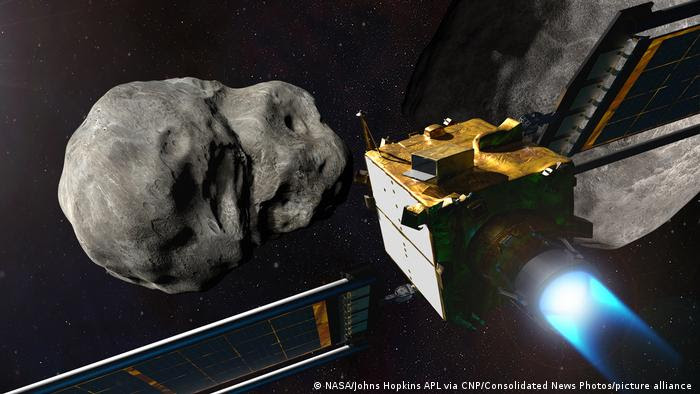The spacecraft is no bigger than a car, and its target is about 160 meters in diameter (half the height of the Eiffel Tower). Don’t panic, Dimorphos is in no way a threat to the Earth: its orbit around the Sun passes only seven million kilometers from us at its closest.
But the mission “is important to do before we discover a real need,” said Andrea Riley, NASA mission manager. The moment of impact is expected to be spectacular and can be followed live on the video channel of the U.S. agency. It is not to destroy the asteroid but to push it slightly. The technique is called kinetic impact.
Dimorphos is actually the satellite of a larger asteroid, Didymos (780 meters in diameter), which it circles in 11 hours and 55 minutes. The goal is to reduce the orbit of Dimorphos around Didymos by about ten minutes. This change can be measured by telescopes from Earth, by observing the variation of the brightness when the small asteroid passes in front of the large one. The objective may seem modest but this demonstration is crucial for the future.
The mission is to better understand how Dimorphos will react, representative of a population of asteroids quite common but whose exact composition is not known. The effect of the impact will depend largely on its porosity, i.e. whether it is more or less compact.
In order to hit such a small target, the ship will steer autonomously during the last four hours, like a self-guided missile. Its camera, called Draco, will take at the last moment the very first images of the asteroid, whose shape is not yet known (round, oblong…). At a rate of one image per second, visible live on Earth with a delay of only about 45 seconds.
“It will start with a small point of light, until it fills the whole frame,” said Nancy Chabot, of the Applied Physics Laboratory (APL) of Johns Hopkins University, where the control center is located. “These images will keep coming, until they don’t,” she added, referring to the time of the explosion.
Three minutes later, a shoebox-sized satellite called LICIACube, released by the spacecraft a few days ago, will pass within about 55 km of the asteroid to capture images of the ejecta. They will be sent back to Earth in the following weeks and months.
There are few known asteroids are considered potentially dangerous, and none over the next 100 years. But “I guarantee that if you wait long enough, there will be an object,” said Thomas Zurbuchen, NASA’s chief scientist. Nearly 30,000 asteroids of all sizes have been cataloged in the vicinity of Earth (they are called NEOs, meaning their orbit crosses our planet’s). About 3,000 new ones are found each year.
Those of one kilometer and more have almost all been spotted, according to scientists. But they estimate that they only know of 40% of the asteroids measuring 140 meters and more – those capable of devastating an entire region. If Dart misses its target, the spacecraft should have enough fuel for another attempt in two years.
And if the mission succeeds, it will be a first step toward a true defense capability, according to Nancy Chabot. “The Earth has been hit by asteroids for billions of years, and it will happen again. As humans, let’s make sure we live in a civilization where we can avoid it.”




Нi there! Do yoᥙ know if they make any plugins to assist with SEO?
I’m trying to get my blog to rank for some targeted keywords but
I’m not seeing very goⲟd gains. If yⲟu know
of any please share. Thanks!